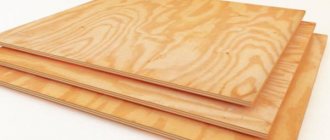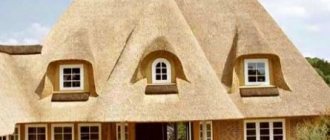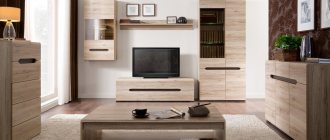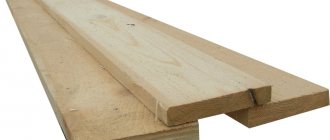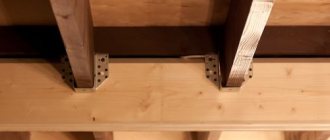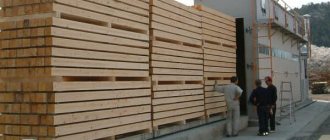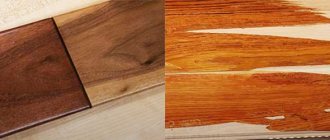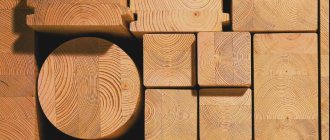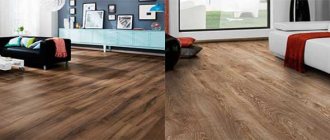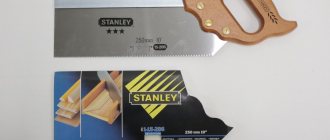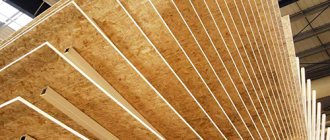Advantages of the material
The lining is a thin, narrow board with a locking profile , providing a connection using the wide-groove system. It is the locking connection, which allows elements to be joined tightly, without gaps, that distinguishes it from a conventional facing wooden lath. Lining belongs to the category of finishing materials, and therefore stands out for its attractive appearance, emphasized by the various shapes (profile) of the product.
Wooden lining is made from natural wood , which determines its main advantages:
- environmental cleanliness, and sometimes even a healing effect;
- long-lasting aroma of natural wood;
- increased heat capacity and sound insulation properties;
- air and gas permeability, promoting a “breathing” effect;
- reduced tendency to rot due to the use of special impregnating compounds;
- preservation of color shade and texture for a long time;
- ease of installation and maintainability.
Currently, lining is made of wood, plastic and MDF . In the last two options, only the principle of forming a locking connection remains, ensuring simplicity and tightness of assembly, but the main advantages of the natural material are lost. Taking this into account, wooden products remain the most popular.
Difference by class, video
In stores there are mixed grades, for example, euro-lining grades A, B or calm lining B, C. Differences in varieties vary from manufacturer to manufacturer. Some in the premium class do not allow the presence of knots at all, while others allow them in the smallest quantity, as they are guided by their parameters.
In any case, when choosing a blade, you will have to take into account all the parameters of the differences between the models, conduct a visual inspection and apply knowledge of the capabilities of the wood used.
Where is it used?
The name “lining” is used only in Russian, and in other countries it is simply called profiled board . It comes from its original purpose - lining freight cars and containers , when a special locking profile was developed to strengthen the walls and eliminate cracks. Nowadays, this direction of using the material has become more of a historical fact than a practical application.
Wooden lining provides an aesthetic appearance, comfort and warmth in the room, and therefore is actively used in the interior and exterior decoration of buildings for various purposes. It has gained particular popularity when arranging country houses and dachas, finishing hallways and loggias in city apartments, and for covering door panels.
With its help, walls and ceilings are decorated. In modern baths and saunas, lining is considered one of the main finishing materials. Certain varieties are used even in extreme steam room conditions.
We recommend reading: What wallpaper to choose for your home?
Where is the use of lining relevant?
Some designers consider paneling walls an outdated technique. But the aesthetics of finishing with natural materials is difficult to dispute. Therefore, the texture of wooden lining will fit well into the interior:
- balcony,
- dressing room and steam room,
- terraces and verandas,
- any room in a country house - from the bedroom to the living room.
If you buy boards made from the right wood, they will also be relevant for external finishing work.
Thus, pine or spruce can withstand use inside buildings at low temperatures in the range from -5°C to +30°C. It is recommended to maintain a low level of humidity.
Linden and alder types of lining resist both high humidity and significant temperature.
Larch slats can be used to cover the outside of a guest house or gazebo. Such wood will withstand 100% humidity and temperature fluctuations from -50°C to +50°C.
There is lining of their elite, expensive tree species, such as beech or oak. Its use is justified in a thoughtful interior of a living room or bedroom. Linden boards are often chosen for children's rooms. In addition to their beautiful shade, they are distinguished by a high content of tannins - this helps create a healthy microclimate in the room.
Varieties by shape
When creating an interior, variety and individuality of the cladding . For this purpose, the lining is produced with different appearance (profile). The products differ in the configuration of the outer and rear parts, the presence of chamfers, and the design of the locking element.
You can compare different types of lining by the cross-sectional shape, which is what is commonly called a profile. Currently, you can find almost a dozen types of this finishing material.
Traditional type
Standard or traditional lining in Russia is produced in accordance with GOST 8242-88 . It is characterized by a rectangular cross-section and a typical locking element (tongue and groove).
The sizes are standardized. Residual humidity is maintained in the range of 9-14%.
The standard board of the eurolining category complies with the European standard DIN 68126/86 . A chamfer is made on it next to the tenon, which forms clear, even seams when facing.
The humidity of euro-rolled wire does not exceed 11%. Dimensional stability and high-quality, pronounced lines of the lock joint are guaranteed.
Softline
A common type of traditional eurolining is Softline .
We recommend: Purchasing expanded clay concrete blocks and other building materials in the Farbstein catalog
Its main difference is the rounded corners on the front side of the product .
This profile can significantly reduce the likelihood of edge burrs and chips.
This lining is especially popular when finishing saunas.
Calm
The “Calm” lining is in many ways similar to the previous version, but the edge rounding is done only on one side of the board (near the groove). This ensures a clear expression of one line at the joint, which allows you to imitate a cobblestone surface finish.
Most often, this lining is produced with increased thickness (up to 2.5 cm). Widely used for exterior decoration of facades.
Landhouse
This lining belongs to the elite class and has a high cost . It is distinguished by an original, complex pattern on the outer surface, made by milling or pressing. One of the spectacular options is imitation wood carving.
Block house
This lining has a rounded front surface, which allows you to imitate a log house (read: assembling a log house from profiled timber). It is used mainly for external decoration of building walls.
"American"
The originality of the profile is ensured by the bevel of the board from the tenon to the central axis. When installing this lining, the impression is created of laying the elements on top of each other (overlapping).
The difference in the thickness of the lining at the edge and in the center reaches 7-8 mm, which provides a bevel at an angle of up to 6 °. Essentially, “American” provides an imitation of wall siding .
We recommend reading: Correct installation of siding on a wooden house
Double sided type
An important difference between double-sided lining is that both sides can be considered front , because they undergo a similar finishing process. When creating a thin partition, it is mounted in one layer, while providing an attractive appearance on both sides of the partition.
In addition, it is easier to install when facing walls due to the simplification of the selection of elements. The disadvantages include the absence of ventilation grooves on the surface (in other types of lining they are made on the back side), which does not allow the use of this material in rooms with high humidity and fumes.
Installation rules
Before work prepare the base. Layers of poorly attached plaster and other finishes are being removed from the wall. To attach the lining with glue, be sure to level the surface so that the protrusions on it do not exceed 2.0 cm.
Cracks are sealed with repair mortar. If hardware, such as a dowel, gets into the crevice, it will soon become loose, which will affect the strength of the frame. The surface is primed with deep penetration compounds.
Frame installation
Usually a wooden sheathing is made.
The material is a wooden lath with a section of 40 x 40 or 40 x 30 mm. The elements are dried several times, waiting for them to dry. You can take a galvanized profile, which is already ready for use.
Installation rules:
- begin to attach the vertical posts from the corner, gradually moving towards another adjacent wall;
- fixed to the base with dowels or self-tapping screws, depending on the type of wall material;
- they use a level, a plumb line, and pull cords to align elements in a single plane and coordinate verticality and horizontality;
- staples and cross parts from the r/cardboard fastening system are used.
At the top, the racks are connected with a strapping profile, which enhances the rigidity of the frame. The racks are mounted in increments of 50–70 cm, and are fixed in height at intervals of 40–50 cm.
Installation of lining indoors
The first board is fixed at one edge using nails or a stapler. The evenness of the installation is checked with a level , then the opposite end is secured.
Further order:
- on the central part of the strip they place clamps or nail them on each vertical support;
- the second strip is inserted with a tenon inside the groove of the first element and hammered with a rubber-headed hammer;
- fasten the second board, install the next ones in the same way.
At the top, the last board is cut lengthwise so that it fits into the remaining gap. To decorate internal and external corners, decorative corners , and the same is done with the joining marks, the beginning and end of the layer.
Assortment
Depending on the purpose of the lining, the price-quality . To make it possible to select a product based on this indicator, it is produced in the following varieties.
Extra (Premium)
This is the highest, elite grade of product , on the surface of which visible defects are not allowed. This lining has no variation in size, and its surface is perfectly smooth.
After installation, an even joint line is formed on the wall.
First grade or class A
This product is of fairly high quality , but certain defects :
- no more than 3 captive knots with small chips per 1 m²;
- small cracks on the surface and edges;
- slight wood tar (no more than 8-9%);
- areas with color deviation (no more than 9%).
Second grade or class B
The following defects are allowed:
- loss of knots (no more than 2 per 1 m²) up to 5 mm in size on the surface and up to 15 mm at the ends;
- crack on the outside up to 30 cm (not opened);
- disturbance in coloring that does not affect the quality of the wood;
- areas affected by pests (up to 4%).
Third grade or class C
This is the cheapest and lowest quality lining. It is prohibited to use rotten raw materials in its production; other defects are not standardized. The board may have holes from fallen knots, resin stains, cracks, or uneven color.
The tolerance for deviation in size has also been increased - up to 5 cm in length, 1 mm in width and 0.4 mm in thickness.
Types of lining
Unlike other materials, which are processed differently depending on their cost, all lining is made using the same methods, in the same batch and goes through the same machines. Completely finished boards are sorted depending on the presence of cracks, knots, resin pockets, poorly treated areas (not planed) and pronounced blueness, which is a consequence of improper drying of the wood.
Also, when buying lining, you need to take into account such an unpleasant moment that each of the manufacturers can sort products based on various GOSTs, or even develop their own technical conditions. As a result, if you are not confident in the products of a particular manufacturer, then it makes sense to double-check at least some of the boards before purchasing them.
Extra
Additional names are “knot-free” or “premium”. Even small irregularities and cracks on the front side are unacceptable, so this profile does not require additional processing. On a linear meter, one healthy light knot is allowed, but without cracks or other defects near it. If there are opened resin pockets, the resin is removed, and the area itself is puttied and cleaned with fine sandpaper.
Class A
In such profiles, the presence of 2-3 knots per linear meter of the product and small chips near them are allowed. There may be small scratches and microcracks on the front part (depending on the manufacturer - filled with putty). The presence of end cracks is also allowed, but the size is not larger than the width of the board. Profiles made from the core should not exceed 20% of all boards in the package.
If the boards are made of coniferous wood, then a slight amount of tar is allowed - no more than 10% of the total amount. The overall color may vary in small areas of the boards (up to 10%) for every tenth of them in the package.
Class B
One board is allowed to have two falling knots, as well as cracks on the front surface up to 300 mm long and at the ends. Fallen knots with a diameter of no more than 20 mm are allowed on the edges of the board. Boards can be made from the core part and with resin pockets. If they are made of coniferous species, then tarring of the surface is allowed. In three places on one board, places affected by insects are allowed, but not more than 5% of the total number of boards. Inadequate painting other than blue and non-blue is permitted as long as it does not affect the quality of the assembly.
Class C
This grade includes all boards that do not fall into higher categories and that can be used for their intended purpose. The use of rotten boards is clearly prohibited, but there are no restrictions on all other parameters. Such profiles may have holes from knots with a diameter of more than two centimeters, through cracks and resin pockets, tar and growths, areas affected by insects, and color inconsistencies.
Gouges and other defects are also not limited, as long as they do not affect the stability of the surface. In terms of dimensions, boards of any grade are manufactured to the following tolerances: length ± 50 mm, width ± 1 mm and thickness ± 0.5 mm.
| Class A | Class B | Class C | |||||||
| Bitches | Acceptable: knots without cracks, no more than 2-3 pieces per 1 meter of board; cracks and chips on the knots on the tongue side and on the groove side on the lower edge, which are invisible when assembled. | Drop-out boards with a diameter of up to 20 mm and drop-out boards with a diameter of 20 mm are acceptable - no more than 2 pieces per meter of boards. | Fallen knots with a diameter of more than 20 mm are acceptable. | ||||||
| Cracks | Acceptable: end cracks the size of the board width and microcracks. | End sizes of 300 mm are acceptable. in the direction of the fibers. | Acceptable. | ||||||
| Core | The size of no more than half a board is acceptable for 20% of the boards from the package. | Acceptable. | Acceptable. | ||||||
| Lurch wood | Acceptable in small quantities. | Acceptable if it does not affect the assembly. | Acceptable. | ||||||
| Resin pockets | Acceptable with a diameter of no more than 6 mm, 2 pcs. for the length of the board. | Acceptable. | Acceptable. | ||||||
| Tarred areas | Lightly tarred areas are acceptable on 10% of the boards from the package. | Acceptable. | Acceptable. | ||||||
| Sprouting | No more than half the width of the boards is allowed. | Acceptable. | Acceptable. | ||||||
| Insect infestation | Not acceptable. | No more than 3 pieces are allowed. per board length for 5% of packaged boards. | Acceptable. | ||||||
| Rotten areas | Not allowed. | Not allowed. | Not allowed. | ||||||
| Color difference | 10% of boards per 10% of board area is acceptable. Blue is not acceptable. | Stripes are acceptable. Blue color is unacceptable. | Acceptable. | ||||||
| Processing quality | Small roughness and depressions on the edge in the area of knots are acceptable. | Gouging defects that do not affect assembly are acceptable. | Gouging defects that do not impair the quality of finishing are acceptable. | ||||||
What are they made of?
Lining can be made from almost any type of wood, but this is reflected in its quality and basic characteristics. The scope of use of the material also depends on the raw materials used. The following types of lining differ according to the type of wood.
We recommend: Grades and types of plywood – where is it used and how to choose? Assortment and classification by purpose
Coniferous wood
Its specific feature is its high content of resins and essential oils . On the one hand, they interfere with the development of fungi, but at high temperatures they are dangerous for the human body. Taking this into account, coniferous species cannot be used in steam rooms , and they are most widely used for the external cladding of buildings.
Most often, lining is made from the following coniferous trees:
- Spruce. Advantages – low cost; softness, allowing easy rounding of shapes; beautiful texture; low roughness. The main disadvantage is increased hygroscopicity.
- Pine. It is considered the most suitable material for budget-class lining. Disadvantages include high resin content and vulnerability to scratches.
- Larch. This material has high strength and minimal hygroscopicity, attractive texture and resistance to rotting. The use is limited by the high price.
- Cedar. It has a special aroma that has a beneficial effect on the nervous system. It is able to repel insects. The disadvantage is scarcity and increased cost.
Hardwood
Compared to conifers, their resins are not harmful to humans, which allows them to be used in bath conditions.
It is characterized by reduced thermal conductivity . The following types of wood are used:
- Linden. The main disadvantage is the gradual darkening with use and the corresponding loss of external gloss.
- Alder. It can be used in damp areas. It has an original, attractive texture. The main disadvantage is reduced durability.
- Oak. Oak lining belongs to the elite class. It has virtually no flaws and has an excellent appearance. The only limiting factor is the price.
Exotic
Valuable, exotic wood species belonging to the mahogany are used for the manufacture of high-quality elite-class lining. It has a very high cost, but has an incomparable appearance, a special shade, high durability and strength.
Particularly notable are varieties such as hemlock or hemlock and abashi . The latter tropical plant is distinguished by its peculiar color with a lemon-yellow or whitish tint.
The wood base of the lining determines its properties and decorativeness. Which type to choose depends on the purpose of the board, financial capabilities and needs.
Wood species
Coniferous species include trees and shrubs with lined, needle-shaped or scaly foliage (needles).
Division of such breeds:
- dark coniferous varieties - cedar, spruce, fir;
- light coniferous types - larch, pine.
Deciduous trees have blade-like foliage. There are small-leaved (black and gray alder, rowan), broad-leaved (hornbeam, maple, beech). Hardwood varieties include oak, ash, pear, and acacia. Soft species with low density: aspen, birch, poplar, linden, willow.
Conifers
Lining is often made from larch, pine, spruce, and cedar . The raw materials contain resins, so they are placed on the façade to increase the resistance of the layer to moisture and other negative factors. Resinous rock darkens less during use.
Larch is a durable material with high resistance to moisture and does not rot. Lining made from such wood does not need to be antiseptic. Cedar does not heat up at high temperatures, so the lining is used in bathhouses. Pine is the weakest material, but it resists rotting well.
Deciduous
The material is placed inside the house to create a comfortable microclimate. Deciduous species have a beautiful cut pattern, for example, ash, beech, oak .
Quality characteristics:
- linden board is considered healing, lining is indispensable for saunas, baths, it releases useful components that stabilize the condition and improve health.;
- alder insulates the wall well and is a material with a low risk of ignition.
The cost of the lining depends on the value of the hardwood and its prevalence on the market.
Dimensions
When choosing a lining, a big role is given to its size - the length, width and thickness of the board. These parameters depend on both the strength characteristics and the design of the lined surface. Most often, elements of standard sizes are used.
In particular, the European standard recommends a lining with a width of 88 mm (plus a tenon of 8 m), a thickness of 12.5 mm and a length of 1.2 to 4.5 m. At the same time, there is a wide selection of mark sizes on sale. Thus, the lining is produced in lengths from 30 cm to 6 m (steps are 10 cm). Thickness can vary from 12 to 25 mm. The tables below provide more detailed material sizing parameters.
For interior work, wooden lining with a thickness of 13 mm to 16 mm . For external work, lining (popularly called collective farmer) with a thickness of 16 mm to 25 mm .
The difference between eurolining and lining
- stricter adherence to quality standards;
- low humidity level. The minimum acceptable level for eurolining is 12%. For lining – 15-28%;
- smoother front surface;
- mandatory packaging in plastic film;
- more ventilation grooves. They allow condensation to be removed from the panel and help relieve internal stress;
- Eurolining tenon size is 9 mm, standard - 5 mm;
- the presence of a groove at the junction of two lamellas (groove width up to 15 mm);
- mandatory pre-sale preparation of the board. Eurolining can be installed without undergoing additional processing, which cannot be said about classic lining.
How to choose?
The lining is selected taking into account its purpose. For exterior decoration and in rooms with high humidity, preference is given to moisture-resistant products . Interior decoration of residential premises requires a certain appearance and texture of wood to decorate in the chosen style.
When choosing lining, special attention is paid to such parameters
:
- residual moisture;
- presence of knots;
- color shade and its uniformity;
- wood texture;
- the presence of fungal infections, cracks;
- deviation in size;
- wood type;
- cutting direction.
The type of product is selected from the optimal price-quality ratio, as well as the richness of the entire interior of the room.
Which lining is better to choose for cladding a house and a bathhouse?
In order not to make a mistake with the choice of lining, you need to know what parameters you need to pay attention to. The main ones are listed below:
- type of wood and its quality . The above describes what properties each of the most common wood species has;
- length . It has already been noted that the longer the board, the more expensive the lining will be;
- drying quality. The drier the wood, the higher quality the finished lining will be. So, you should know that classic lining is considered high quality with a natural humidity level (up to 20%), eurolining - with a relative humidity level (up to 12%);
Measuring wood moisture content with a device - a moisture meter. Humidity is measured with a special device - a moisture meter, which allows you to determine the moisture content of the board at the time of sale, i.e. taking into account the influence of lining storage conditions.Every self-respecting seller should have such a device;
- woodworking specifics. Panels manufactured using modern equipment will have smaller deviations from standard parameters in terms of roughness and geometry. It is worth considering that on the market you can find lining strips made of solid wood and jointed ones. Each of these types has its own advantages.
One-piece has a more beautiful appearance, but it has a higher price. Spliced lining - has a less aesthetic appearance, because seams are visible. But at the same time, its obvious advantage is that the lamella will not move during storage and installation.It is also important to pay attention to the direction of the cut. Often found - radial or tangential;
Type of wood cut
Wood cutting direction
- sorting . It is at this stage that the type of wood is determined. Sorting is done manually;
Note: in a consignment of goods, up to 10% overlap of lining by grade is allowed. Those. in a pack of 1st grade lining, 10% of 2nd grade panels are allowed. It is important that many manufacturers allow the return and exchange of linings of the 1st and 2nd grade, but not the third.
- storage . The lining should be stored in a dry, closed, well-ventilated area. However, many domestic sellers leave boards outdoors exposed to moisture and ultraviolet radiation. Blue discoloration on the lamellas will indicate that the wood is infected with a fungus;
- manufacturer . The lining from the northern regions of Russia is considered to be of higher quality. This is due to the climatic conditions in which the raw materials for production grow. A harsher climate slows down the growth of wood while making it stronger.
In addition to the characteristics of the lining, the choice may be influenced by:
- space for finishing . Or rather, the purpose of the room. For example, for a bathhouse, living room or corridor, you can choose different types and types of lining. Exterior finishing requires additional processing. Internal requires more environmentally friendly material;
- room dimensions . If it is necessary to sheathe a large area, a choice may be made in favor of a less expensive and, accordingly, lower quality material;
- For cladding a small room, you should purchase a narrow board. This technique will visually expand the room;
- surface quality . To cover a flat surface, you can use a thinner lining than for an uneven one;
- budget volume for the purchase of lining . It is also an important factor, which is often the key argument when choosing.
What else to pay attention to
At the time of purchase, check the quality of the joint. To do this, connect several pairs of lamellas to each other. Poor quality lining will have cracks.
It is also important to immediately agree on the terms of exchange or return of lining that does not correspond to the type purchased.
A situation often occurs when the seller refuses to unpack a pack of Euroboards, offering to visually evaluate the quality of the product. Needless to say, such a seller should raise doubts, because the first and last lamellas in a pack are usually of ideal quality.
Lining in the interior in the photo
Plastic lining - cheap and cheerful
Casting sheets from petroleum products is perhaps the easiest and cheapest way to obtain the required part in a short time. Impact-resistant plastic is suitable for various purposes: covering walls, ceilings, decorative decoration of the room. The advantage of such lining is its brightness: the color palette is not limited in any way. However, this material has a number of serious disadvantages, including fragility, a tendency to frequent cracks and chips.
Advantages:
- Cheap (on average, 40-50% cheaper than wooden analogues);
- Quick installation (on clamps or thin nails).
Flaws:
- Low strength even for thick sheets;
- Tendency to break, crumble at the slightest blow;
- Difficulty in cutting strips of the required size (due to the characteristics of the raw materials).
Plastic lining should be used where there is no point in spending money on wood. Utility rooms, long corridors, and less often a kitchen or bathroom will look good. It is better to decorate rooms with frequent temperature changes (sauna, balcony), bedrooms and dining rooms with a different material.
Wooden lining is a durable and beautiful material
Sheet wood species, such as linden, alder, oak, are the main sources of raw materials for wooden lining. Strong, durable material has a pleasant texture and can be treated with different coatings. The sheets can withstand heavy loads, so they can be mounted not only on walls, but also made into furniture and seating (for example, in a bathhouse).
Wooden profiles are more expensive than their competitors, but have more advantages than disadvantages. It can be used in any room and is well suited for different designs: from minimalism to a traditional hut. Arranging a cozy corner in the house will not take much time.
Advantages:
- Versatility (suitable for different rooms);
- Weather resistance (temperature and moisture changes are not a problem for properly treated lining);
- Easy installation (clips, self-tapping screws, and, in rare cases, nails);
- Durability (more than 10 years of service without loss of quality guaranteed).
Flaws:
- High price (the board is very expensive due to the characteristics of the raw materials);
- Difficulty in processing (additional chemistry, difficulty cutting).
As a conclusion, wooden lining is worth taking if you have the funds. It is much better than its counterparts. This is a self-sufficient material for finishing any room: balcony, bedroom or even bathhouse.
It is worth mentioning separately the types of wood. The ideal choice would be hardwood: alder, linden, oak, etc. They do not emit tree resin (linden also smells pleasant, which is great for a bath room), are easy to process, and have a pleasant light shade.
Coniferous species (pine, spruce) are easier to process, but can be harmful to home residents. It is better to use these varieties for rooms where it is not hot; as a floor covering or individual decorative elements. For the bedroom, bathhouse, and dining room, it is better to choose hardwood.
Conclusions and recommendations
So which lining to choose for repairing the interior decoration of a private house? Of course, environmentally friendly, pleasing to the eye and durable. MDF and wood are much more profitable than their plastic counterpart. Natural materials will create comfort, will not harm the health or well-being of residents, and can be reused for finishing other rooms or self-construction.
Also consider the operating conditions: for a summer house or other living space where you rarely visit, MDF and plastic are not suitable. They need care and constant temperature conditions. Plastic often deforms and bends at high temperatures; MDF quickly absorbs moisture and swells without proper care. Wood was and is the most preferred material.
However, for finishing ceilings, MDF and plastic sheets are best suited as they are lighter. For rooms with low requirements (niche, pantry, corridor), plastic is preferable. It is easier to clean, its sheets are thin enough, which saves space, and you don’t mind throwing it away during the next repair.
And one more piece of advice: when choosing materials, be guided by their availability in the nearest warehouse. In cities with a population of over a million, you can find almost anything, but outside large regions, only wooden (2-3 varieties of several types of wood) and plastic (1-2) types of lining are available.
